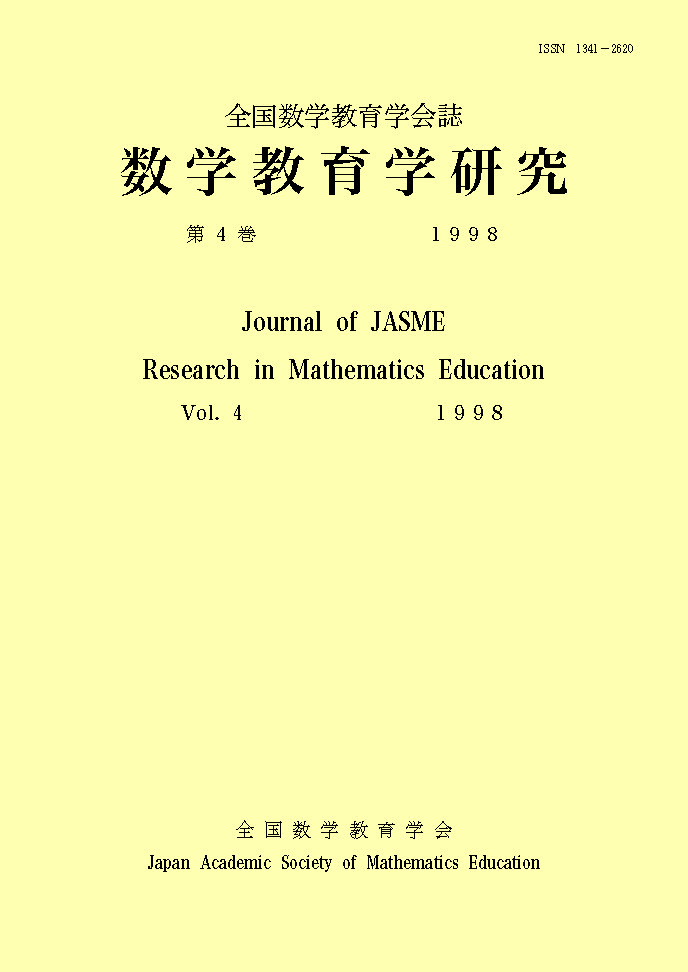4 巻
選択された号の論文の25件中1~25を表示しています
- |<
- <
- 1
- >
- >|
-
原稿種別: 本文
1998 年 4 巻 p. 1-9
発行日: 1998年
公開日: 2019/01/17
PDF形式でダウンロード (1161K) -
原稿種別: 本文
1998 年 4 巻 p. 11-17
発行日: 1998年
公開日: 2019/01/17
PDF形式でダウンロード (883K) -
原稿種別: 本文
1998 年 4 巻 p. 19-27
発行日: 1998年
公開日: 2019/01/17
PDF形式でダウンロード (964K) -
原稿種別: 本文
1998 年 4 巻 p. 29-35
発行日: 1998年
公開日: 2019/01/17
PDF形式でダウンロード (910K) -
原稿種別: 本文
1998 年 4 巻 p. 37-44
発行日: 1998年
公開日: 2019/01/17
PDF形式でダウンロード (975K) -
原稿種別: 本文
1998 年 4 巻 p. 45-51
発行日: 1998年
公開日: 2019/01/17
PDF形式でダウンロード (828K) -
原稿種別: 本文
1998 年 4 巻 p. 53-61
発行日: 1998年
公開日: 2019/01/17
PDF形式でダウンロード (1096K) -
原稿種別: 本文
1998 年 4 巻 p. 63-69
発行日: 1998年
公開日: 2019/01/17
PDF形式でダウンロード (905K) -
原稿種別: 本文
1998 年 4 巻 p. 71-82
発行日: 1998年
公開日: 2019/01/17
PDF形式でダウンロード (1450K) -
原稿種別: 本文
1998 年 4 巻 p. 83-103
発行日: 1998年
公開日: 2019/01/17
PDF形式でダウンロード (2572K) -
原稿種別: 本文
1998 年 4 巻 p. 105-113
発行日: 1998年
公開日: 2019/01/17
PDF形式でダウンロード (1085K) -
原稿種別: 本文
1998 年 4 巻 p. 115-122
発行日: 1998年
公開日: 2019/01/17
PDF形式でダウンロード (966K) -
原稿種別: 本文
1998 年 4 巻 p. 123-128
発行日: 1998年
公開日: 2019/01/17
PDF形式でダウンロード (845K) -
原稿種別: 本文
1998 年 4 巻 p. 129-136
発行日: 1998年
公開日: 2019/01/17
PDF形式でダウンロード (999K) -
原稿種別: 本文
1998 年 4 巻 p. 137-145
発行日: 1998年
公開日: 2019/01/17
PDF形式でダウンロード (1075K) -
原稿種別: 本文
1998 年 4 巻 p. 147-152
発行日: 1998年
公開日: 2019/01/17
PDF形式でダウンロード (719K) -
原稿種別: 本文
1998 年 4 巻 p. 153-164
発行日: 1998年
公開日: 2019/01/17
PDF形式でダウンロード (1429K) -
原稿種別: 本文
1998 年 4 巻 p. 165-176
発行日: 1998年
公開日: 2019/01/17
PDF形式でダウンロード (1499K) -
原稿種別: 本文
1998 年 4 巻 p. 177-185
発行日: 1998年
公開日: 2019/01/17
PDF形式でダウンロード (1001K) -
原稿種別: 本文
1998 年 4 巻 p. 187-195
発行日: 1998年
公開日: 2019/01/17
PDF形式でダウンロード (1097K) -
原稿種別: 本文
1998 年 4 巻 p. 197-207
発行日: 1998年
公開日: 2019/01/17
PDF形式でダウンロード (987K) -
原稿種別: 本文
1998 年 4 巻 p. 209-217
発行日: 1998年
公開日: 2019/01/17
PDF形式でダウンロード (1085K) -
原稿種別: 本文
1998 年 4 巻 p. 219-229
発行日: 1998年
公開日: 2019/01/17
PDF形式でダウンロード (1551K) -
原稿種別: 本文
1998 年 4 巻 p. 231-235
発行日: 1998年
公開日: 2019/01/17
PDF形式でダウンロード (670K) -
原稿種別: 本文
1998 年 4 巻 p. 237-244
発行日: 1998年
公開日: 2019/01/17
PDF形式でダウンロード (1049K)
- |<
- <
- 1
- >
- >|
